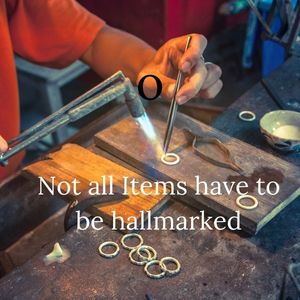What is UK Hallmarking?
We are often asked about hallmarking so we thought it would be helpful to put together this handy guide. Hallmarking is the process of verifying and certifying the purity of precious metals such as gold, silver, platinum, and palladium. In the UK, hallmarking is a legal requirement for most items made from these metals if they are to be sold as such.
A hallmark is a set of official marks applied to an item to guarantee its metal content. These marks are applied by one of the UK’s four Assay Offices located in London, Birmingham, Sheffield, and Edinburgh. The system is regulated under the UK Hallmarking Act 1973.
Components of a UK Hallmark
What do the different letters in a hallmark mean?
There are 4 components of a UK Hallmark.
Sponsor’s Mark: Identifies the maker or importer of the item. Here at Flutterby, we have our own unique sponsor’s mark. It is a version of the letter ‘F’ set in a diamond shape imprint.
Metal and Purity Mark: Indicates the type of metal (gold, silver, platinum, or palladium) and its fineness (purity) in parts per thousand.
Assay Office Mark: Identifies the specific Assay Office that performed the hallmarking.
Date Letter (this is optional): Indicates the year of hallmarking. On 1 January 2025, all four UK Assay Offices began using the new letter for the year. This year it is an uppercase ‘A’. The date letter changes every year – but a new typographic alphabet is issued every 25 years as it was this year. The typographic alphabet is changed every 25 not 26 years because of the potential confusion between the letters ‘i’ and ‘j’.
We love looking at old pieces of jewellery and finding out more about each piece by looking at the hallmark. You’ll need a jewellery loop to get a closer view but if you haven’t got one, then try taking a photo with your phone and enlarging the photo to see if you can see the date as well as the sponsor’s mark!
Why is Hallmarking Important?
- Consumer Protection
- It ensures buyers are purchasing items made from genuine precious metals of the stated purity.
- Reduces the risk of fraud or misrepresentation by unscrupulous sellers.
- Trust and Transparency
- Hallmarking builds trust between sellers and consumers by providing an independent guarantee of quality and authenticity.
- It establishes confidence in the jewelry and precious metals market.
- Legal Compliance
- Selling items made from precious metals without a hallmark (if required) is illegal in the UK. Hallmarking ensures businesses comply with UK laws.
- Fair Trade
- It levels the playing field by holding all sellers to the same standard, ensuring that genuine products are not undercut by counterfeit or substandard items.
- Historical and Cultural Value
- The hallmark system has been in place for over 700 years in the UK, making it one of the oldest consumer protection measures in history.
- Hallmarks provide historical data that can help trace the origin and authenticity of antique items.
Exemptions to Hallmarking
Certain items are exempt from hallmarking, such as those below a specific weight:

- Gold: 1 gram
- Silver: 7.78 grams
- Platinum and Palladium: 0.5 grams
UK hallmarking is a cornerstone of the precious metals industry, ensuring integrity, transparency, and trust. For consumers and businesses alike, it offers assurance that the items they buy or sell meet legal and quality standards, protecting the reputation of the UK’s jewellery and precious metals market. You will often find that on silver pieces weighing less than 7.78 grams ‘925’ is stamped on each piece. This isn’t a hallmark but does denote the purity of the silver which is 92.5% – the same as for sterling silver.

